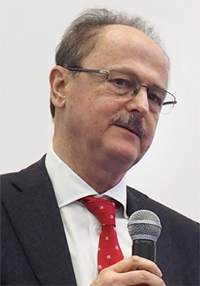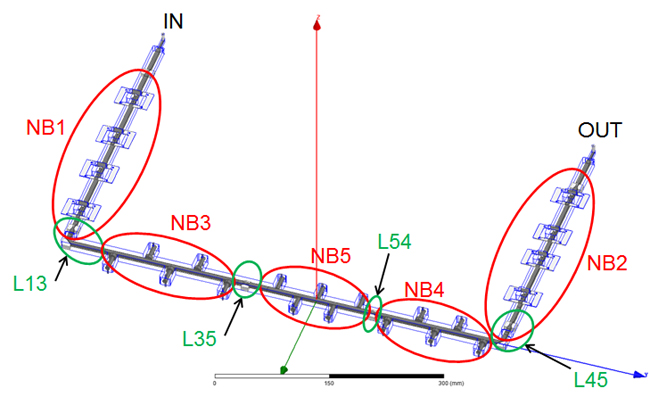The Design Challenge
Expo Milano 2015 was a universal exposition that hosted over five thousand events in six months. The organizers had contracted with several mobile service providers to deploy stations throughout the expo area to provide complete mobile service coverage for the event. In addition, Italian government security services relied on mobile base stations strategically placed throughout the expo to ensure communications for the event, including the public safety network (Figure 1).

However, the lobe of one of the mobile service antennas directly interfered with the communication signals of a critical security control base station and the issue had to be resolved immediately as the expo was opening in less than a month. RF Microtech was asked to provide a validated full-wave electromagnetic (EM) simulation of a 2-port ultra-wideband (UWB) filter that could reject all five mobile service bands with greater than 35 dB of rejection. Furthermore, the filter had to ensure 80 MHz to 6 GHz wide-band transmission with insertion losses less than 2 dB RF Microtech’s client, H3G, also required that the device fit within a 1x1x0.2 meter enclosure, while still providing acceptable levels of coexistence to 6 GHz without signal degradation. The validated EM simulation had to be delivered within two weeks and the complete deployable device by the time the expo opened.
The Solution
The RF Microtech design team immediately went to work developing a circuit model of five independent notched-band filters (NBFs) cascaded along a transmission line (Figure 2).

The team chose NI AWR Design Environment, specifically Microwave Office circuit design software, for this time-critical project. Each independent filter was designed as a 4th or 5th order NBF, composed of several cascaded stages of N shunt resonators. The individual filter specifications required that the filter resonators’ high unloaded Qs be > 1000, with the additional challenge of having no spurious modes under 6 GHz. Each of the transmission line and filter sections were then implemented in ANSYS HFSS full-wave electromagnetic (EM) analysis tool. The S11 and S21 results (Figure 3) corresponded well with the initial circuit simulation.

To save optimization time in the full-wave simulator, the simulation results of the filters and interconnecting transmission line blocks were imported back into Microwave Office for several optimization trials, which required over 17 Touchstone blocks with 16 transmission line connections to be imported from HFSS into Microwave Office, the goal being to reduce the overall insertion loss by improving the return loss between filter sections using properties of the connecting transmission lines. After completing the optimization of the transmission line segments (Figure 4), the entire filter was imported into HFSS for a validating full-wave simulation. With the deadline closing and the design validation results looking promising, the filter was fabricated and tested.

Why NI AWR Design Environment
With a single full-wave simulation of the entire filter structure requiring a minimum of 46 hours—over 36.5 percent of the available project window—Microwave Office circuit simulation features were heavily relied upon to optimize filter and transmission line structures to meet the steep performance requirements. The resulting comparison of the Microwave Office circuit simulation, the full-wave EM validation, and the final fabricated filter, as shown in Figure 5, demonstrates the highly accurate, while still rapid, effectiveness of Microwave Office circuit optimization.

RF Microtech’s urgent needs were well met by the high quality yet fast Microwave Office circuit simulation tool and its compatibility with HFSS EM simulation enabled the successful completion of a complex filter design in a fraction of the time such a project would normally take. Using Microwave Office software cut simulation time by 90 percent compared to exclusively using a full-wave EM simulation flow.
The final filter design was evaluated by both H3G and the Italian government, who found the final product (Figure 6) satisfactory for their needs.

Company Profile
 RF Microtech, Perugia, Italy, is a service company developing custom RF and microwave products for industries and system integrators. The company covers all areas of RF and microwave technology and offers innovative solutions for the most demanding applications in the areas telecommunication, aerospace, defense and security, safety, medical, manufacturing industry, logistics, and localization. RF Microtech was founded in 2007 as a spin-off out of the University of Perugia by Professor Roberto Sorrentino and his group of former students in the microwave engineering laboratory of the Department of Electronic and Information Engineering.
RF Microtech, Perugia, Italy, is a service company developing custom RF and microwave products for industries and system integrators. The company covers all areas of RF and microwave technology and offers innovative solutions for the most demanding applications in the areas telecommunication, aerospace, defense and security, safety, medical, manufacturing industry, logistics, and localization. RF Microtech was founded in 2007 as a spin-off out of the University of Perugia by Professor Roberto Sorrentino and his group of former students in the microwave engineering laboratory of the Department of Electronic and Information Engineering.

